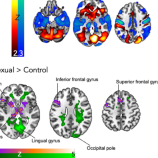
Articles
-
May 28, 2024 |
nature.com | Natalie Ertl |Matthew Wall |Shelan Ofori |Anna Borissova |Will Lawn |Kat Petrilli | +3 more
Adolescence is a time of rapid neurodevelopment and the endocannabinoid system is particularly prone to change during this time. Cannabis is a commonly used drug with a particularly high prevalence of use among adolescents. The two predominant phytocannabinoids are Delta-9-tetrahydrocannabinol (THC) and cannabidiol (CBD), which affect the endocannabinoid system. It is unknown whether this period of rapid development makes adolescents more or less vulnerable to the effects of cannabis on brain-network connectivity, and whether CBD may attenuate the effects of THC. Using fMRI, we explored the impact of vaporized cannabis (placebo, THC: 8 mg/75 kg, THC + CBD: 8 mg/75 kg THC & 24 mg/75 kg CBD) on resting-state networks in groups of semi-regular cannabis users (usage frequency between 0.5 and 3 days/week), consisting of 22 adolescents (16–17 years) and 24 young adults (26–29 years) matched for cannabis use frequency. Cannabis caused reductions in within-network connectivity in the default mode (F[2,88] = 3.97, P = 0.022, η² = 0.018), executive control (F[2,88] = 18.62, P < 0.001, η² = 0.123), salience (F[2,88] = 12.12, P < 0.001, η² = 0.076), hippocampal (F[2,88] = 14.65, P < 0.001, η² = 0.087), and limbic striatal (F[2,88] = 16.19, P < 0.001, η² = 0.102) networks compared to placebo. Whole-brain analysis showed cannabis significantly disrupted functional connectivity with cortical regions and the executive control, salience, hippocampal, and limbic striatal networks compared to placebo. CBD did not counteract THC’s effects and further reduced connectivity both within networks and the whole brain. While age-related differences were observed, there were no interactions between age group and cannabis treatment in any brain network. Overall, these results challenge the assumption that CBD can make cannabis safer, as CBD did not attenuate THC effects (and in some cases potentiated them); furthermore, they show that cannabis causes similar disruption to resting-state connectivity in the adolescent and adult brain.
-
May 14, 2024 |
nature.com | Matthew Wall |Jonathan Howard |Tia Hunjan |Paul A. Bassett |Layla Thurston |David Goldmeier | +10 more
Distressing low sexual desire, termed Hypoactive Sexual Desire Disorder (HSDD), affects approximately 10% of women and 8% of men. In women, the ‘top-down’ theory of HSDD describes hyperactivity in higher-level cognitive brain regions, suppressing lower-level emotional/sexual brain areas. However, it is unknown how this neurofunctional disturbance compares to HSDD in men. To investigate this, we employed task-based functional MRI in 32 women and 32 men with HSDD to measure sexual-brain processing during sexual versus non-sexual videos, as well as psychometric questionnaires to assess sexual desire/arousal. We demonstrate that women had greater activation in higher-level and lower-level brain regions, compared to men. Indeed, women who had greater hypothalamic activation in response to sexual videos, reported higher psychometric scores in the evaluative (r = 0.55, P = 0.001), motivational (r = 0.56, P = 0.003), and physiological (r = 0.57, P = 0.0006) domains of sexual desire and arousal after watching the sexual videos in the scanner. By contrast, no similar correlations were observed in men. Taken together, this is the first direct comparison of the neural correlates of distressing low sexual desire between women and men. The data supports the ‘top-down’ theory of HSDD in women, whereas in men HSDD appears to be associated with different neurofunctional processes.
Try JournoFinder For Free
Search and contact over 1M+ journalist profiles, browse 100M+ articles, and unlock powerful PR tools.
Start Your 7-Day Free Trial →